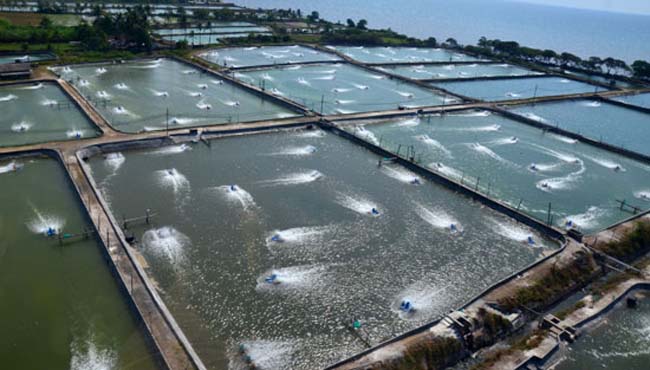Bacteria that play a role in the decomposition process of organic matter consisting of several types, such as nitrification, denitrification, and extracellular enzyme-producing bacteria. Bacteria that can produce extracellular enzymes needed for bioremediation of organic waste are called heterotrophic bacteria. The process of decomposition of organic matter involves various types of bacteria such as proteolytic, cellulolytic, amylolytic, nitrification, and denitrification.
Heterotrophic bacteria are one of the biological agents acting as decomposers of food waste and organic matter at the bottom of the water. The remaining feed and metabolic waste in the cultivation system can reduce pond water quality. Organic material from the leftover feed, stool, and died organisms settle at the bottom of the pond is used as a substrate for the growth of microorganisms. The pond sediment layer from the surface to several centimeters (1 – 25 cm) contains higher nutrients than the upper water column because the sediment serves as a counterweight to the concentration of water nutrients. The study aimed to obtain extracellular enzyme-producing bacteria, which could be the initial reference as bioremediation agents.
Pond sediments are a collection of organic materials located at the bottom of the pond that is formed through sedimentation. The source of organic material in cultivation is mostly (90%) derived from the feed, and the rest comes from the water. Sedimentation occurs because the water cannot distribute organic material as it has a mass greater than water, so it settles in the bottom of the water. Sediment is one of the factors that affect pond water quality. The abundance of bacteria in sediments influences the process of reforming organic matter as well as nitrite and ammonium compounds produced in pond sediments.
Pond sediment is one of the factors that influence the quality of environmental waters. High organic matter (10-100 mg/kg in pond water and 10,000-200,000 mg/kg in pond sediments) can cause algal blooms, which result in sudden mass death. The accumulation of organic matter in pond sediments caused a decrease in the survival rate of cultivated organisms. The accumulation and alteration of organic matter carried out by bacteria occurs at the bottom of pond sediments.
Heterotrophic bacteria live by obtaining food in the form of organic matter from the environment because they cannot arrange their organic material needed. Organic material is obtained from the rest of other organisms, waste, or substances contained in the body of other organisms. The characteristics of heterotrophic bacterial groups are motile, not sporoid, aerobic, and generally, including Gram-negative bacteria. Heterotrophic bacteria get food, oxygen, and energy derived from the results of the decomposition process.
Heterotrophic bacteria are bacteria that utilize organic matter and can degenerate organic matter in the growing environment as a nutrient for its growth. Organic matter is the main source of carbon and energy for the growth of heterotrophic bacteria. Organic matter was decomposed by heterotrophic bacteria through the oxidation process, which is the process of breaking down complex compounds into simpler compounds. Heterotrophic bacteria play an important role in maintaining the balance of water quality because heterotrophic bacteria can digest materials directly from the abiotic environment, from material released as a result of excretion of fish, or from dead organisms in aquatic ecosystems. Organic materials in the water are decomposed by heterotrophic bacterial into inorganic compounds, and the nutrient turned into potential biomass for the growth of heterotrophic bacteria.
The role of bacteria in pond sediments is to produce extracellular enzymes (Protease, cellulase, and amylase). Extracellular enzyme-producing bacteria can be the initial reference as bioremediation agents. Enzymes are protein molecules that act as catalysts in enzymatic reactions. Enzymes act as catalysts to accelerate biochemical reactions in pond soil and water in the bioremediation process. When the enzyme is added to aquaculture water or spreads on pond soil, enzymes can degrade the main elements of organic matter found in ponds.
Enzymes can be produced and excreted by several microbes. Extracellular enzymes (proteases, cellulase, and amylase) are produced during aerobic fermentation of organic matter by microorganisms, for example, Bacillus. Extracellular enzymes are enzymes that work outside the cell. These enzymes change the nutrient so that it can enter the cell. For example, amylase breaks down starch into simple sugars.
Heterotrophic bacteria can produce extracellular enzymes needed for bioremediation of organic waste. Heterotrophic bacteria help the process of decomposition of organic nitrogen waste from feed and metabolic waste and then converted to bacterial biomass. To live, microorganisms need nutrients coming from outside the cell, so microorganisms in fulfilling nutritional needs actively produce and secrete digestive enzymes or hydrolyze complex compounds into simple compounds that can enter the cell.
Out of twenty bacterial isolates found from pond sediments, 4 bacterial isolates can produce proteolytic, amylolytic and cellulolytic extracellular enzymes. The four isolates are Bacillus thuringiensis, Bacillus lentus , Bacillus sphaericus, and Corynebacterium pilosum.
Author: Luthfiana Aprilianita Sari, S.Pi., M.Sc.
Related article at:
https://iopscience.iop.org/article/10.1088/1755-1315/236/1/012003
OA Artha1, Sudarno1, H Pramono2 and LA Sari1
Identification of extracellular enzyme-producing bacteria (proteolytic, cellulolytic, and amylolytic) in the sediment of extensive ponds in Tanggulrejo, Gresik
Published under licence by IOP Publishing Ltd
IOP Conference Series: Earth and Environmental Science, Volume 236, conference 1
doi:10.1088/issn.1755-1315
Online ISSN: 1755-1315/ Print ISSN: 1755-1307





